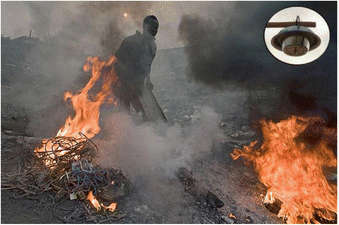Source characterization and risk of exposure to atmospheric polychlorinated biphenyls (PCBs) in Ghana |
| |
| Authors: | Jonathan N Hogarh Nobuyasu Seike Yuso Kobara Derick Carboo Julius N Fobil Shigeki Masunaga |
| |
| Institution: | 1.Department of Environmental Science, College of Science,Kwame Nkrumah University of Science and Technology,Kumasi,Ghana;2.Faculty of Environment and Information Sciences,Yokohama National University,Yokohama,Japan;3.Division of Hazardous Chemicals,Institute for Agro-Environmental Sciences, National Agriculture and Food Research Organization (NARO),Tsukuba,Japan;4.Department of Chemistry,University of Ghana,Legon,Ghana;5.Department of Biological, Environmental & Occupational Health Sciences, School of Public Health,University of Ghana,Legon,Ghana |
| |
| Abstract: | With recent evidence that persistent organic pollutants (POPs) such as polychlorinated biphenyls (PCBs) are emerging in environmental media in some developing countries that otherwise have sparing production and usage history, it has become important to identify such contemporary source factors of PCBs and the risks this may pose, in line with the global consensus on POP management and elimination. The present study investigated contaminations from atmospheric PCBs in Ghana, deciphered source factors, and accessed risk of exposure to dioxin-like PCBs (DL-PCBs). Atmospheric PCBs were monitored by deployment of PUF-disk passive air samplers (PAS) at several sites across Ghana for 56 days. Atmospheric ∑190PCB concentration in Ghana ranged from 0.28 ng/m3 in Kumasi to 4.64 ng/m3 at Agbogbloshie, a suburb in Accra noted for informal electronic waste (e-waste) recycling activities. As high as 11.10 ng/m3 of PCB concentration was measured in plumes from uncontrolled open burning of e-wastes at Agbogbloshie. Applying statistical source characterization tools, it emerged that e-wastes were a major contributor to the environmental burden of atmospheric PCBs in Ghana. The risk of DL-PCB toxicity via inhalation in the Agbogbloshie area was 4.2 pg TEQ/day, within similar order of magnitude of an estimated risk of 3.85 pg TEQ/day faced by e-waste workers working averagely for 8 h per day. It is suggested that elimination of e-waste sites would help to significantly reduce PCB-related toxicity issues in Ghana. |
| |
| Keywords: | |
| 本文献已被 SpringerLink 等数据库收录! |
|

